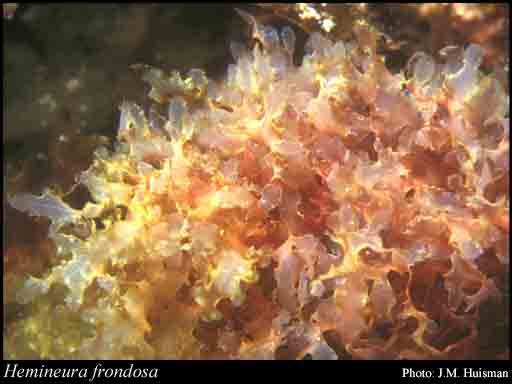- Reference
- Nereis australis 116 (1849)
- Conservation Code
- Not threatened
- Naturalised Status
- Native to Western Australia
- Name Status
- Current

Scientific Description
Habit and structure. Thallus medium red to red-brown, 5–40 cm high, complanate, usually irregularly branched with elongate axes and main branches 0.5–2 cm broad bearing marginal proliferations, sometimes foliose and 4–10 cm broad with crispate margins; marginal proliferations elongate-ovate to lanceolate, 5–10(–20) mm long and usually 2–4 mm broad. Midrib present in all blades, not extending to that in the parent blade, becoming corticated; wings 120–250 µm thick, present to near base of the thallus, lost from a short stipe. Holdfast discoid to lacerate and fibrous, 1–5(–20) mm across; epilithic or occasionally epiphytic or epizoic. Structure. Apical cells broadly obconical, segmenting to axial cells each with 2 lateral pericentral cells and later 2 transverse ones, the lateral pericentral cells forming second-order rows with only occasional cells forming third-order cells or short rows; transverse intercalary divisions occur in second- and third-order rows, with only the second order rows and outermost third-order cells reaching the blade margin; the surface cell arrangement of the blade becomes irregular. The blade margin has some cells projecting as slight dentations and dividing, some of which recommence growth to form new marginal exogenous blades with apical cells dividing as in the main blades, but without the new midrib connecting back to that in the parent blade. Cortication occurs first over the midrib from the transverse pericentral cells, and the cells of the wings cut off a layer of smaller cortical cells on both sides; in older parts the cortex becomes 2 cells thick and 3–4 cells thick over the midrib; transverse sections show a regular arrangement of a central layer of large, shortly obloid cells 60–120(–150) µm across and cortical layers of small, dimidiate, cells 20–35 µm across. Mature cells multinucleate; rhodoplasts discoid, chained in larger cells.
Reproduction. Gametophytes dioecious. Procarps developed in series from transverse pericentral cells on both sides of the blades, with each supporting cell forming 2 sterile cells (groups) and two 4-celled carpogonial branches. Carposporophytes with an elaborate, branched, fusion cell, much branched gonimoblast and short terminal rows of clavate to ovoid carposporangia 35–50 µm in diameter, maturing sequentially. Cystocarps situated on the midrib, single, hemispherical, 0.8–2 mm across, ostiolate, with a beaked pericarp 4–8 cells thick. Spermatangia in small to extensive sori on both sides of the wings, forming rounded to elongate-oblong patches, with spermatangia cut off from cortical initials. Tetrasporangial sori scattered, becoming extensive between the midrib and margins, 250–300 µm thick, with tetrasporangia in 2 irregular layers of mixed ages, cut off mainly from inner cortical cells, with an overlying cortex of small cells; tetrasporangia subspherical, 40–90 µm in diameter.
Distribution.Houtman Abrolhos, W. Aust., to Gabo I., Vic., and around Tas.
[After Womersley, Mar. Benthic Fl. Southern Australia IIID: 33–35 (2003)]
Distribution
- IMCRA Regions
- Leeuwin-Naturaliste.
- Local Government Areas (LGAs)
- Cockburn, Rockingham.